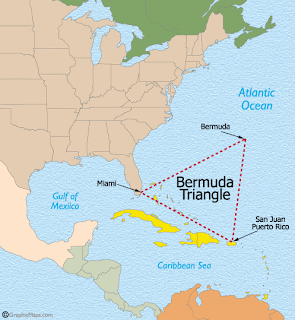Mystery of Bermuda Triangle
4:36 AM
 For over forty years, the Bermuda Triangle has been popularly known for supposedly paranormal disappearances of boats and aircraft. This imaginary triangle, also known as "Devil's Triangle," has its three points at miami, puerto rico and bermuda Actually, despite several factors which should contribute to higher rates of accidents in the region, the Bermuda Triangle has been found to be no more statistically dangerous than other areas of the open ocean.
For over forty years, the Bermuda Triangle has been popularly known for supposedly paranormal disappearances of boats and aircraft. This imaginary triangle, also known as "Devil's Triangle," has its three points at miami, puerto rico and bermuda Actually, despite several factors which should contribute to higher rates of accidents in the region, the Bermuda Triangle has been found to be no more statistically dangerous than other areas of the open ocean.The popular legend of the Bermuda Triangle began with a 1964 article in the magazine ArgosyNational Geographic and Playboy merely repeated the legend without additional research. Many of the disappearances discussed in these articles and others did not even occur in the area of the Triangle. that described and named the Triangle. Further articles and reports in such magazines as.
The 1945 disappearance of five military airplanes and a rescue plane was the primary focus of the legend. In December of that year, Flight 19 set out on a training mission from Florida with a leader who wasn't feeling well, an underexperienced crew, a lack of navigation equipment, a limited supply of fuel, and rough seas below. Though the loss of Flight 19 may have initially seemed mysterious, the cause of its failure is well documented today.
There are a few real hazards in the area of the Bermuda Triangle that contribute to the accidents that occur in the wide swath of sea. The first is the lack of magnetic declination near 80° west (just off the coast of Miami). This agonic line is one of two points on the earth's surface where compasses point directly to the North Pole, versus to the Magnetic North Pole elsewhere on the planet. The change in declination can make compass navigation difficult.
Inexperienced pleasure boaters and aviators are common in the area of the triangle and the U.S. Coast Guard receives many distress calls from stranded seamen. They travel too far from the coast and often have an insufficient supply of fuel or knowledge of the swiftly moving Gulf Stream current.
Overall, the mystery surrounding the Bermuda Triangle is not much of a mystery at all but has simply been the result of an overemphasis on the accidents which have occurred in the area.
The incident that consolidated the reputation of the Bermuda Triangle was the disappearance in December 1945 of Flight 19, a training squadron of five U.S. Navy torpedo bombers. The squadron left Fort Lauderdale, Florida, with 14 crewmen and disappeared after radioing a series of distress messages; a seaplane sent in search of the squadron also disappeared. Aircraft that have disappeared in the area since this incident include a DC-3 carrying 27 passengers in 1948 and a C-124 Globemaster with 53 passengers in 1951. Among the ships that have disappeared was the tanker ship Marine Sulphur Queen, which vanished with 39 men aboard in 1963.
Books, articles, and television broadcasts investigating the Bermuda Triangle emphasize that, in the case of most of the disappearances, the weather was favorable, the disappearances occurred in daylight after a sudden break in radio contact, and the vessels vanished without a trace. However, skeptics point out that many supposed mysteries result from careless or biased consideration of data. For example, some losses attributed to the Bermuda Triangle actually occurred outside the area of the triangle in inclement weather conditions or in darkness, and some can be traced to known mechanical problems or inadequate equipment. In the case of Flight 19, for example, the squadron commander was relatively inexperienced, a compass was faulty, the squadron failed to follow instructions, and the aircraft were operating under conditions of deteriorating weather and visibility and with a low fuel supply. Other proposed explanations for disappearances in the Bermuda Triangle include the action of physical forces unknown to science, a “hole in the sky,” an unusual chemical component in the region's seawater, and abduction by extraterrestrial being
The Bermuda Triangle (a.k.a. the Devil's Triangle) is a triangular area in the Atlantic Ocean bounded roughly at its points by Miami, Bermuda, and Puerto Rico. Legend has it that many people, ships and planes have mysteriously vanished in this area. How many have mysteriously disappeared depends on who is doing the locating and the counting. The size of the triangle varies from 500,000 square miles to three times that size, depending on the imagination of the author. (Some include the Azores, the Gulf of Mexico, and the West Indies in the "triangle.") Some trace the mystery back to the time of Columbus. Even so, estimates range from about 200 to no more than 1,000 incidents in the past 500 years. Gilarno claims that in 1973 the U.S. Coast Guard answered more than 8,000 distress calls in the area and that more than 50 ships and 20 planes have gone down in the Bermuda Triangle within the last century.

Post a Comment